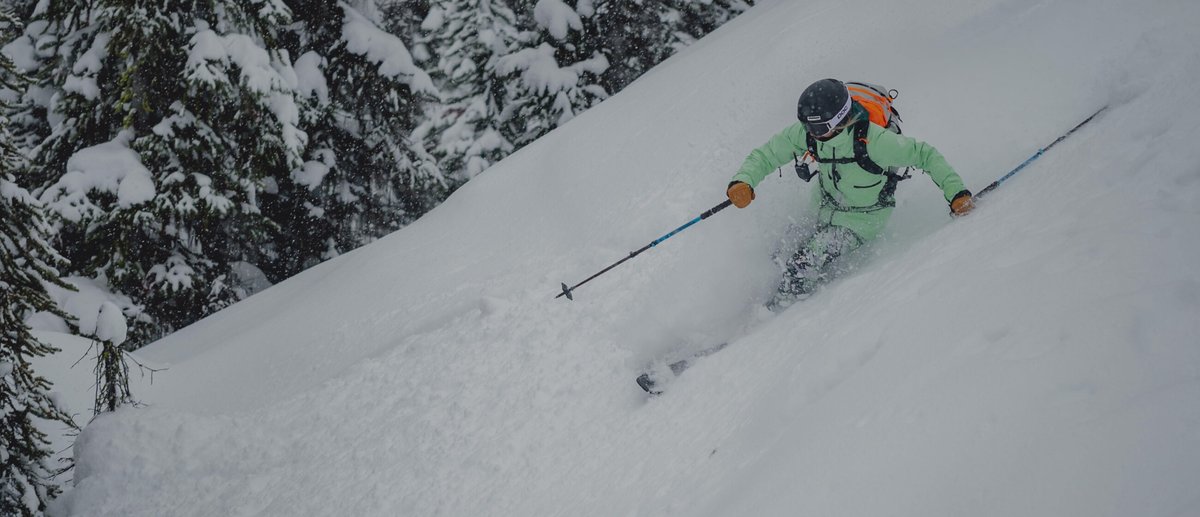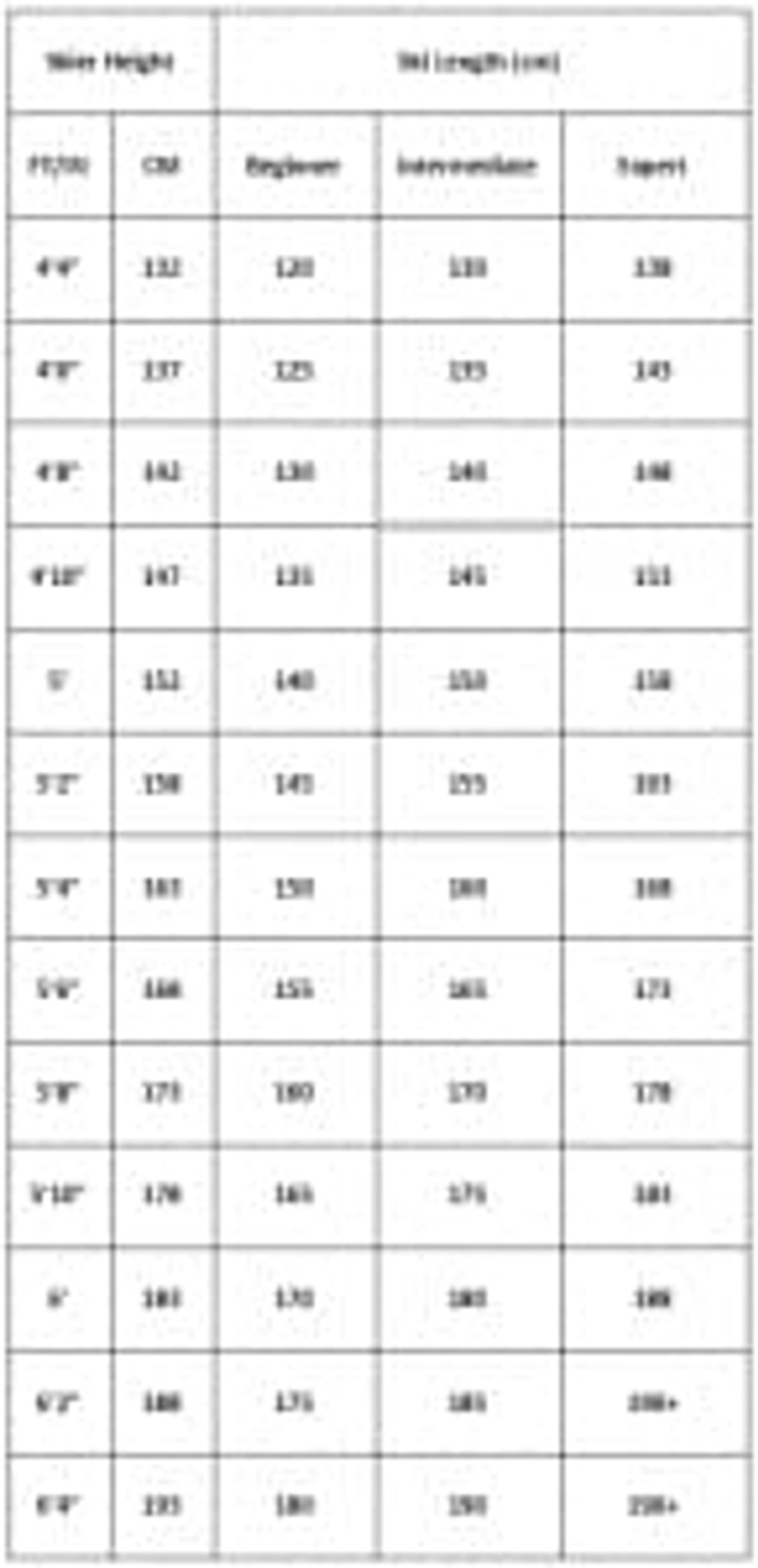
Ski Size Chart: How to Choose the Right Ski Length
How to Determine the Correct Ski Length and Width
Choose the Right Ski Length
What Makes The Perfect Ski Purchase?
While there’s no equation that looks like (height x weight)/(skill level)√magical number = perfect length in the skiing world, there are a few tips that can point you in the right direction.
Likewise, there’s no formula regarding width; the prevailing sentiment post-fat-ski-revolution seems to be, “Ski the widest ski you can without sacrificing performance,” and as a generalization, we tend to agree. But should you ski on wider skis? And if so, how wide do you go?
Dial Your Ski Size According To Height & Skill Level
While there’s no single formula to give you the right size, there is a good old rule of thumb to point you in the right direction.
Take your height and convert it to centimeters. Use that number as an indicator of the ski lengths you should be considering.
- Your height will be the mid-point of a 30-centimeter range of ski lengths.
- For example: a 5-foot 9-inch person is about 175cm tall, that individual should be seeking a ski somewhere in between 160cm and 190cm long.
- A beginner should start at the lower end of the range, while a more advanced skier will likely prefer something longer.
Another way to describe this is to use the head of the skier as a reference: a beginner should start somewhere under the chin and work up to the nose, while an advanced skier can start at the nose and continue up from there. Here’s a basic guide to dialing down your optimal ski size:
Ski Size Chart


It’s All About Size
Length changes the way a ski performs while you’re riding straight, turning, and moving at different speeds.
- Shorter skis make the ski nimbler, leading to quicker turns and more maneuverability at slower speeds, but lose stability as you go faster.
- Longer skis will have a wider turn radius and increase stability at higher speeds but tend to be more sluggish at slower speeds.
- Taller, heavier people, and more advanced skiers tend to prefer longer skis because they have more leverage over the ski and feel more comfortable making longer turns.
- Shorter, lighter people, and less-experienced skiers will usually feel more comfortable with the maneuverability of a shorter ski.
Matching Skill Level To Your Skis
Beginner/Intermediate Skiers are newer to the sport and are building their fundamental skills, like lining up consecutive turns with confidence and using the edges of their skis properly. The goal here is to find a ski that’s designed for easy turning, with added forgiveness if you do make a mistake. These riders should look for skis with:
- Softer flex
- Narrower widths
- Composite, foam, or softer wood cores
- Capped constructions
Intermediate/Advanced Skiers are riders who are comfortable carving on groomers, sometimes find themselves in deeper powder but aren’t exactly dropping into the toughest terrain on the mountain. These riders should be looking for skis with:
- Medium-stiff flex
- Medium-wide width
- Stronger core construction
- Full camber, rocker, or some combination of both
Advanced/Expert Skiers are much more aggressive riders who feel confident at high speeds and comfortable dropping into the steepest sections of the mountain. These riders should be looking for skis with:
- Stiffer flex
- Wide widths
- Strong core construction: titanal, carbon, flax, or other materials meant to deliver better performance at speed
Where Do You Ski?
An expert skier in Vermont will ski a far different ski than an expert in British Columbia. Consequently, replace “expert” with “beginner” or “intermediate” and this fact remains true. This has largely to do with terrain and snow type.
Between powder, groomers, and ice, which are you skiing on a more regular basis? Are you an East Coast front-side ripper or a backcountry slasher?
- If you ski on the East Coast, you probably want to peruse All-Mountain Skis for the short and sharp knives.
- West Coasters generally like to browse Big-Mountain Freeride Skis for riding the steep and deep.
- If you’re a ski-tripper looking to get a little bit of everything, check out well-balanced All-Mountain Skis.
- Heading for the park or some urban rails when the sun drops? Check out Park and Pipe Skis.
What About Effective Edge?
One thing to remember is that your ski’s profile (shape) is going to change its effective edge, or the length of the edge that is in contact with the snow when you’re skiing on a relatively hard surface.
- Cambered skis have a long effective edge because the points of contact are close to the tip and tail
- Cambered skis with an early-rise tip make the effective edge shorter because the point where the edge engages the surface is further back
- Hybrid-profile skis with the shorter effective edge will offer less control at speed and less stability in variable conditions but will float better in powder
For that reason, you may wish to go a little longer if you’re getting a ski that’s rockered (early tip and/or tail rise) or has a rocker-camber combination.

Finding The Right Ski Width
Wider powder skis allow you to float above the snow instead of sinking into it, while narrow skis enable you to hold a stronger edge on hard surfaces.
- Wider skis spread the weight of a skier over a larger surface area, making the skier effectively lighter per square inch of surface.
- On a narrow ski, the binding and your boot are close to the edge, so it takes less force to place and hold that ski on its edge on hard snow.
- Soft snow deforms under the weight of the skier, so a wider ski will flatten out the irregularities and be more stable underfoot.
- Hard snow doesn’t deform as easily, so a narrower ski is needed to concentrate the weight of the skier and give the edges purchase for turning.
- Narrow skis will give you great grip on hard snow, but they’ll be very twitchy and unstable on anything else.
- The widest skis fall in the 145–150mm range at the waist; any wider and the force on the ankles will be too great, even in soft snow.
Where the balance between stability and edging performance lies is a matter of preference, but here is a loose guide we made up for ski waist widths, using no scientific instruments whatsoever:
Ski Width Chart:


The Last Word
There will always be exceptions to the rules we’ve outlined. Just like any of the other characteristics that define a ski, length and width are something you choose based on the way you ski, the terrain and snow you ski on, and the way you want to ski it.
The most important lesson to take away from this article is that nobody can tell you what ski you should be using. It’s up to you to go out there and borrow, rent, or demo skis until you know what feels right.